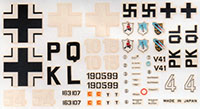
Hasegawa 1/32 Messerschmitt Me 163 Komet Kit First Look
By Michael Benolkin
| Date of Review | April 2017 | Manufacturer | Hasegawa |
|---|---|---|---|
| Subject | Messerschmitt Me 163 Komet | Scale | 1/32 |
| Kit Number | JS087 | Primary Media | Styrene |
| Pros | Easy build | Cons | See text |
| Skill Level | Experienced | MSRP (USD) | OOP |
First Look
 |
 |
 |
The Me 163 was aptly named Komet for its ability to streak through bomber formations. Designed by Alexander Lippisch, the Me 163 was the only rocket-powered to ever become an operational combat aircraft - ever. Powered by a single HWK-109 engine, the Me 163 would take-off with a wheeled dolly which would be jettisoned after getting airborne, climb above the bomber formations, then translate any remaining power to speed before the fuel was expended. The aircraft was armed with a pair of 30mm MK108 cannons which it would use against the bombers until it ran out of ammo or energy (airspeed). The Me 163 would dive for home as a glider and land on the grass using its belly skid. In the concept of air defense, the Me 163 was the poster child for point air defense since it couldn't afford to wander far from home.
While the Komet was terrifying to see zipping through bomber formations, it wasn't operationally effective. Any malfunctions with the fuel system would usually melt the pilot. While the aircraft was faster than anything else in the air at the time, it was extremely vulnerable to fighters that would simply wait near its homebase for one to glide home. The MK108 cannons were intended for relatively close engagement which was nearly impossible for an aircraft flying as fast as the Me 163. If Germany had time to gain experience with the Me 163 and arm it with a suitable weapon, the results would have been devastating.
Hasegawa has been in existence since 1941, butit didn't enter the plastic model market until the early 1960s and had found success with their box scale kits of the day. By the early 1970s, Hasegawa had settled into what we consider 'standard scales' for their kits and by that time had produced an impressive catalog of kits. Pushing into 1/32 scale, Hasegawa released kit number 87 in the early 1970s, the Messerschmitt Me 163 Komet which was one of a series of kits in thie scale that pioneered the easy-to-build but with nice details (for the day). Many of us have owned these kits or have them stashed away in our collections. This is another of Hasegawa's classic kits which was the best Me 163 in 1/32 scale for decades. Like the full-scale aircraft, the kit is very simple, presented on two parts trees plus one small tree of clear parts.
Among the features and options in this kit:
- Detailed HWK-109 engine
- Basic cockpit
- Landing skid molded extended (though you can easily fix that for in-flight display)
- Optional wheeled dolly for take-off
- Choice of faired or unfaired tailwheel unit
- Tail cone is removable to display rocket engine
- Rocket engine can be left removable (twist lock)
The kit you see here is the original boxing (kit JS087) but the kit is periodically reissued. Like some of the other classic reissues however, the retail price seems to be heading higher as well. Nevertheless, you can find this kit at hobby flea markets and contests for very reasonable prices, especially after the Meng kit was released. While this kit doesn't have the details of the Meng offering, there are a variety of aftermarket cockpits and detail sets which will bring this model up to speed at a fraction of the cost.







